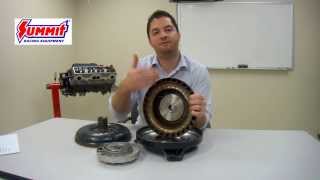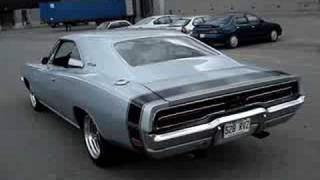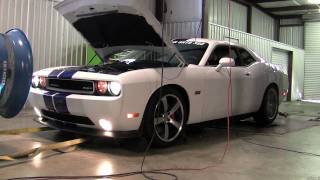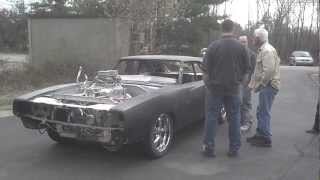Wednesday, 24 December, 2025г.
















Где искать: по сайтам Запорожской области, статьи, видео ролики
пример: покупка автомобиля в Запорожье
Dodge Charger stock torque converter stall speed test 2 - foot brake flash
Dodge Charger and challenger - R/T - R/T Road and track, Daytona, Srt8, seem to come with a stock 2400 stall torque converter, In This test the car is at full throttle and the brakes are holding it back completely, I must say its a little tricky to determine the maximum foot brake stall speed, you must flash it up a bit in order to get a true result, or it will seems to lock up at a lower rpm, If you just do a flash stall test, "with no brakes", it seems to lock up at 1800 rpms, its the systems (EMCC) hard at work here, its designed so that it does not flash all your shifts when your just cruising around, so its almost like putting the car in race mode with a few rpm rev's, you have to tell it, hey - wake up, I want you to launch me like a rocket.
You've probably noticed this in regular driving, after you floor it once or twice the car really wakes up, shifts quicker, and even holds your down shifts a lot longer for you, boom - race mode.
After doing the stall speed tests and letting her rip, the transmission
held my gears for a long time as it was shifting down, back into
cruse mode, the transmission actually stayed in 4th gear till I got to
the lights, which was 3 miles down the road, normally it would
shift into 5th gear for cruising.
The system monitors the transmission as shifts occur and adjusts the hydraulic pressure as needed, this five-speed transmission also uses an Electronically Modulated Converter Clutch (EMCC) to control torque converter clutch slippage, the charger's transmission uses highly advanced electronic shift controls, this transmission is on the 5.7-liter 345 cu in v8 HEMI EZB MDS in this video.
The transmission model is a W5A580 - 5 speed.
The two basic ways to determine your stall speed are "flash stall" or "foot brake stall", flash stall is when your at idle and you just floor it, the torque converter will slip to a given rpm speed and then it will couples up and engage, to thrust you forwards, that rpm is your stall speed, its like letting your foot off the clutch petal at a higher rpm, or dropping the clutch.
The second way to determine your stall speed is foot brake stall, at idle again, you put your foot brake on full and ease the gas petal to the floor, to bring the rpms up as high as it can go until one of two things happen, one your foot brake will hold back the full power of your engine and you can take that as your stall speed, or two the brake will not be able to hold back the engine's power and the tires will start spinning, at that braking point is your stall speed.
Now with the new electronics and system monitors, I find i can get a higher stall speed by holding the brakes full and instead of just easing the gas petal to full throttle, I rev the engine a few times while brake is on full, and quickly try to get to a higher rpm.
I call it flashing up the torque converter, and it seems to work.
So can I call this method a - "Foot Brake Flash Stall" - or did I
just invent this term.?...(grin).
This car is basically stock, except for an Aem cold air intake and muffler delete, it has stock two piston brakes, and stock 18 in tires, a year later they came out with 4 piston Bremo brakes, with a 20 in tire option, for this model, if I'm not mistaken.
I would really like to hear from people that have better upgrades,
and if they can hold it back with more horsepower. Maybe someone knows how to fine tune the torque converter.? electronically of course, The 06 Charger R/T - R/T in this video is full throttle at 2400 rpm stall speed.
But don't worry I'm not done yet ... you just know I'll do my best to
flash it higher, I'll let you know if I can brake 2400 stall speed
with the stock torque converter.
One last thing, I hear there is a stock 1200 or 1500 stall torque converter on the 3.5-liter V-6 and the basic R/T's...hum...I bet I could get her up a few more digits...what do ya think...? After all, I heard
story's that this car only had a 1600 - 1800 stall to a 2000 - 2200 stall...Go Figure.!
Have fun with your trials and errors...feel free to drop a comment.
Теги:
Dodge Charger R/T r/t Road and Track Daytona Challenger Srt8 Stock torque converter foot brake flash 2400 stall speed test auto transmission speedometer lock couple clutch slip Mopar 5.7 hemi mds 345 inch Engine 6.4 performance how redline reviews burnout muscle car tips show tach 1500 1600 1800 2000 2200 2600 2800 3000 3200 3400 3600 3800 4400 aem intake best exhaust sound cam chip super bee magnum Drag Racing Start Race night time 0-100 tci Street Cars Chrysler 300c package 6.1
Похожие видео
Мой аккаунт


 У вашего броузера проблема в совместимости с HTML5
У вашего броузера проблема в совместимости с HTML5


